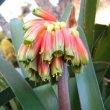Clivia nobilis
| Botanical Name | Clivia nobilis |
|||||||||||
| Family | Amaryllidaceae - The amaryllis family. |
|||||||||||
| Pronunciation | KLY-vee-ah NO-bil-iss |
|||||||||||
| Common Name(s) |
English: Bush lily; Cape clivia
IsiXhosa: ugobeleweni
|
|||||||||||
| Plant Group |
|
|||||||||||
| Plant Size |
|
|||||||||||
| Position |
|
|||||||||||
| General Information |
|
|||||||||||
| Specific Information | Clivia nobilis grow from a tuberous rhizome (which is highly toxic) from which a mass of thick roots grow. The dull, green strap shaped leaves arise from the ground and form a dense clump. In deep shade the leaves are somewhat upright and can grow to 80cm in length, while in light shade the leaves lie almost horizontally and are much shorter, being 20 - 25 cm long. The leaves make a good contrast with both the flowers and the bright red, marble sized seeds, which remain on the plant for a year before they ripen. Clivia nobilis is the slowest growing of all the Clivia species. Many populations of Clivia nobilis in its natural habitat have been destroyed as a result of over harvesting by plant collectors. Mole-rats, (not Moles), are partial to clivia and if you are plagued by these pesty little mammals it is best to consider keeping these bulbs in a container. Care must be taken if damage by slugs, snails and snout beetles is noticed as these may need to be eliminated. |
|||||||||||
| Ad Break | ||||||||||||
| Flowers | ||||||||||||
| Description | 40 - 60 tubular flowers hanging in a cluster from a thick stem |
|||||||||||
| Season |
|
|||||||||||
| Colour |
|
|||||||||||
| Growth Rate |
|
|||||||||||
| Plant Uses |
|
|||||||||||
| Distribution and Habitat | in isolated groups along the coast from the Alexandria Forest to Coffee Bay in the Eastern Cape, on dune sand, river banks and on shale and rocky outcrops, in low bush cover or high forest canopy |
|||||||||||
| Planting Suggestions | Plant in full or dappled shade with plenty of compost and mulch, and water regularly during spring and summer. Clivia nobilis can survive with much less water than Clivia miniata. Feed and compost during the summer months for better results. Watering can be greatly reduced during the winter months, when the plants are at rest. If planted in containers make sure the soil is well drained and rich in compost. Use a liquid fertiliser to keep them well fed. Although they need good air circulation, cold winds will cause serious, long term damage so make sure they are placed in a sheltered position. The best method of propagation is to split up the clumps but bear in mind that Clivias resent being moved and can take up to two years to flower after being separated. Do not lift them until they are over-crowded and show signs of stress, such as reduced flower quality and quantity - or a cracked container! If you are prepared to wait for 6 or more years until they flower, Clivia nobilis can be grown from seed. When you are ready to sow, remove the pulp from the pearly white seeds and plant in a deep tray (they will stay there for two years), filled with a sterilised seedling mix. Press the seeds gently into the mix, just level with the soil surface and keep an eye out for algal growth on the soil surface. Seeds will germinate in four to six weeks. |
|||||||||||
| Medicinal Uses | The rhizomes of clivias are toxic and the medicinal use of them is not encouraged. At low doses, ingestion causes salivation, vomiting and diarrhoea, while higher doses result in paralysis and collapse. Clivias in the wild are collected for magical and medicinal uses. |
|||||||||||
| Ad Break | ||||||||||||








Comments
Hi lorrain, what is the
Hi lorrain, what is the possibility and price for bulbs to be sent to the uk? I am planting a SA garden in Portugal and would like your help with some sugestions?
Bulbs for export
Hello Andre
As I do not have permits for exporting plants I am unable to help you. However Rob from the Shire Wild Bulb Nursery is an exporter and has a wide range of South African bulbs as well as knowledge about them. He is reliable and reasonably priced. Click on the link for his nursery on the right hand side of this page to go directly to his website. I am sure you will find what you are looking for.
Regards
Lorraine
something is eating the clivia roots
The clivia root system is being eating leaving the leaves to stay green for a while before turning brown. U can see the hole where the roots were.i have had about twenty of my clivia's attacked like this. I sprayed but its not clivia worm. The roots are eaten only.Help pls.
Clivia eaten by Mole Rats
Hi Anne
From your clear description, the cause of your problem can only be from Mole Rats. Go to my blog at http://kumbulanursery.co.za/blog/those-moles-again, where I have described the difference between Moles and Mole Rats.
If you have not already removed the remains of the Clivias that have been eaten, you will still be able to save some of them. The mole rats often hollow out the bulbs, leaving the remains of the outer part of the bulbs. If you leave these in the ground, the remains of the bulbs will send out roots and the plants will recover in time. Where the whole bulb has been eaten and you are left with only a bunch of leaves, hold the leaves firmly together at the base and plant them in a pot just deeply enough to hold the leaves in place. I have had some, not all, of my clivias actually send out roots from the base of the leaves.
Mole Rats will often ignore a patch of bulbs for years, then almost overnight will destroy the lot. These pests will eat almost any bulb including Albuca, Gladiolus, Watsonias, Haemanthus, Scadoxus, Cyrtanthus, Dierama, root vegetables... the list goes on. The only bulbs I have come across that can safely be left in the ground are Brunsvigia, Boophone, Veltheimia and Eucomis, although there are bound to be others.
Mole Rats are the bane of my life but there is no way to get rid of them. They do not respond to any of the methods used to get rid of Moles. They may disappear for a while as they eat their way through the bulbs in other gardens, but they will be back. I have now got many of my bulbs planted in lined crates and old baths.
You have my sympathy. It is heart-breaking to see the remains of one's prized bulbs after these little brutes have chomped their way through them.
Kind regards
Lorraine
Discuss this plant
Share knowledge, ask a question or give an experience.